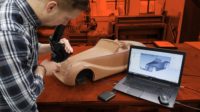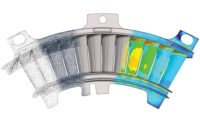Reverse Engineering: A Practical Perspective
With the right tool set the process of reverse engineering is pretty straightforward.












When most people hear the term ‘reverse engineering’ they immediately associate it with knocking off someone else’s product design. Though this is certainly one definition it is far removed from the practical implementation of reverse engineering by today’s design and manufacturing engineers.
Innovative reverse engineering techniques are currently being applied in virtually every aspect of the design and build process, including:
- Capturing organic and other complex surface profiles as part of the design process
- Scanning complex surface profiles for model-based inspection
- 3-D scanning of castings and parts with large surface areas to program more efficient machine tool paths
- Recreating legacy parts during Maintenance, Repair and Overhaul (MRO) that either lack CAD data, or are subject to stress causing the original part specification to no longer apply
Though each of these reverse engineering applications are vastly different they all have one thing in common: the need to capture highly accurate surface points and reverse engineer them back into 3-D CAD models for manufacturing and inspection. This allows design and manufacturing engineers to continue forward with a modern model-based digital workflow. That’s right; sometimes you need to take a step in reverse in order to continue forward.
TECH TIPSThe quickest part of the reverse engineering process is usually the scanning or digitizing of the part. Manipulating the points on the other hand can be quite time consuming to obtain a manufacturing quality 3-D model. To expedite the 3-D modeling process it is import to select reverse engineering software that provides productivity tools to automate 3-D modeling |
Most of today’s modern manufacturing processes require a 3-D CAD model to produce parts. The CAD model is the center of the model-based enterprise and the authority dataset for every step of the design, manufacturing and inspection process. Thirty years ago most manufacturing was driven by 2-D drawings created by hand or 2-D CAD. Twenty years ago cost effective Windows based computers had enough processing power, memory and graphics capabilities to support evolving CAD/CAM software platforms; today 3-D Model Based CAD/CAM is pretty much the design standard.
This continuing evolution of CAD has supported greater integration of quality inspection/reporting and valuable Product Manufacturing Information (PMI) data into the model-based enterprise. This requires the capture of digital attributes more than ever before. Reverse engineering delivers usable 3-D CAD data back into the process.
With the right tool set the process of reverse engineering is pretty straightforward. Depending on the complexity of the part to be captured you will need a suitable 3-D capture device. There are many to choose from including portable or stationary CMMs equipped with a variety of probing systems or noncontact scanners. Contact vs. noncontact scanning is a popular question. To get the right answer you need to ask another question: how much data do you need to get the results you are looking for?
Noncontact scanning is capable of capturing millions of points, creating very large point clouds, which is great but there is a processing cost overhead associated with large point clouds. On the other hand, touch probing, though more accurate, can take more time to capture enough points to create a good 3-D model.
The quickest part of the reverse engineering process is usually the scanning or digitizing of the part. Manipulating the points on the other hand can be quite time consuming to obtain a manufacturing quality 3-D model. To expedite the 3-D modeling process it is import to select reverse engineering software that is intuitive and provides productivity tools to automate 3-D modeling. If you are using a noncontact 3-D laser line scanner, you are essentially painting the part (similar to painting a house) with overlapping scan passes. The software must interpret the multiple overlapping passes and sometimes multiple files sources into a complete 3-D representation that can be ultimately used downstream for CAD/CAM, 3-D printing, assembly guidance, or automated inspection.
The process is broken down into three steps:
1. MEASURE
A suitable CMM or scanner is used to measure and capture 3-D features and surfaces as point clouds, including planes, cylinders, cones, spheres, lines, splines, circles and slots. As the term point cloud infers the collected data is a group of relative points in space without any connecting structure or geometry between them.
2. MESH
The reverse engineering software will in essence connect the dots of the point cloud data applying geometry to create watertight mesh and STL models ready for surfacing and suitable for 3-D printing. This includes alignment and merging of meshes, filtering, smoothing and filling holes. For some applications, like 3-D copying, this is as far as you need to go.
3. MODEL
In order to work with the data as a 3-D CAD model the mesh file must be converted into 3-D surfaces and solid models. This is accomplished by the reverse engineering software, which can export the file to popular CAD formats to support precision manufacturing, guided assembly and automated inspection.
A good reverse engineering solution should be viewed as a multifaceted tool; when placed in the hands of creative design or manufacturing engineer the solution should be applicable to many challenges across the manufacturing enterprise, from precision manufacturing and guided assembly to automated inspection/reporting. When considering reverse engineering software make sure it is an open platform supporting all digital measuring devices, popular CAD/CAM software and common database formats.
To avoid frustration and lengthy editing look for performance tool sets that let the software do the heavy lifting. And above all, ask for customer references that do similar applications to yours, or ask for a demonstration using your own part. Often canned demonstrations by software companies include a lot of backend work that you won’t see, making the process appear effortless. Investing in a reverse engineering solution can prove very valuable, but do your homework.
Looking for a reprint of this article?
From high-res PDFs to custom plaques, order your copy today!















